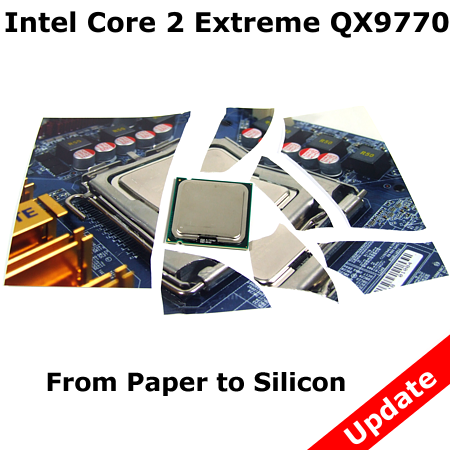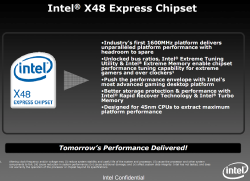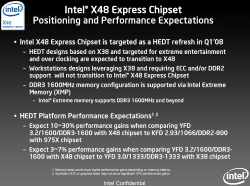Intel Core 2 Extreme QX9770: UPDATE
Intel Core 2 Extreme QX9770 - Updates
Apparently, our article caused quite a stir at a certain processor company's headquarters, so we thought it was time to give you an update on what has happened since this article went online.
Intel contacted us in response to this article, informing us that the Core 2 Duo Extreme QX9770 was in no way a "paper tiger". To back up that claim, Intel Germany sent us a real, tangible silicon version of the chip by courier the next day. Additionally, we received some answers to the questions that had cropped up in our original piece.
The specifications of the QX9770 at 3.20 GHz have changed slightly compared to those of the QX9650 at 3.00 GHz Compare Prices on Core 2 Extreme QX9650 . For example, the core voltage has been given a minor increase from 1.2500 V to 1.2875 V. That's nothing unusual, and could be due to fluctuations in the production process, which is a normal "fact of life" for any line of CPUs.
QX9770 Voltage
CPU-Z-Screenshot of the Core 2 Extreme QX9770 that Intel sent us.
We measured the power consumption of the new CPU and compared it to that of the QX9650. Running both CPUs at an identical frequency of 3.00 GHz on a 333 MHz FSB (1333QDR) with stock core voltage, we measured a difference of roughly 26 watts. On our Gigabyte GA-X38-DQ6 motherboard, the QX9770 running at 3.20 GHz drew 103.5 W, while its predecessor, the QX9650, was more frugal, undercutting its younger sibling by 30.6 W.
Get Tom's Hardware's best news and in-depth reviews, straight to your inbox.
The new model also operated stably at 4.00 GHz once we increased its core voltage to 1.40 V. Here we saw the benefits of the K-Gate technology used in Intel's 45 nm process.
Meanwhile, Intel has confirmed that the QX9770 is rated at a TDP of 136 watts, meaning that its maximum thermal dissipation was raised by 6 watts compared to the QX9650.
Intel's comment: "The TDP is a specification that is primarily of interest to system builders (OEMs). It allows the OEM to design a system that can handle the heat generated by the processor based on this value. The unchanged TDP rating simplifies the process of designing and building new systems. To the end user, the value that is more interesting is power consumption on a system level, i.e., how much power the entire PC, server or laptop consumes."
We also asked Intel whether a new chipset with full official support for the new FSB speed of 400 MHz (1600QDR) would be required to run the new CPU. After all, Intel's current high-end X38 chipset is only specified for a maximum FSB speed of 333 MHz (1333QDR). It seems very unlikely that an OEM computer company such as Dell or HP would ship systems pairing the new CPU with the X38 platform.
Intel's view of the matter is that it considers its warranty voided if its products are operated outside of their specifications, regardless of whether the product in question is a CPU or a chipset. If a motherboard vendor advertises the overclocking potential of its product, then that company is liable for any damage to the CPU or the chipset that results from overclocking, and has to cover the cost.
In other words, if a motherboard maker claims that its board is designed for a 400 MHz FSB (1600QDR), then it has to ensure that the product is up to that task by using voltage regulators that can handle the higher strain without producing errors or becoming unstable. Based on Intel's statements about the new chipset for its 400 MHz FSB CPUs (1600QDR), we see that Intel is discouraging the use of the X38 chipset for this purpose, and will only guarantee compatibility with the X48 chipset.
If we were salespeople in a store and a customer asked us for a motherboard recommendation to go with an FSB1600 CPU, we would always go with the X48 board. After all, if the overclocked X38-based motherboard caused any problems, despite the FSB only running 66 MHz above its stock voltage, we would be faced with additional costs and a very unhappy and unsatisfied customer.
If you buy a Core 2 Extreme QX9700, you should be able to run it in an X38-based board, which is, incidentally, exactly what Intel suggested we do to test this processor in the first place. However, if things do go wrong and the CPU or board are damaged, things may turn sour for you. Intel would most likely waive any warranty claims on the grounds that the chipset was being used outside of its specifications.
The Core 2 Extreme QX9770 we received from Intel also uses the C0 stepping.
Intel's Core 2 Extreme QX9770, live and in the....silicon.
BIOS POST screen
BIOS settings: 9x multiplier and a 400 MHz FSB
When we inquired again about what price point the company plans for selling the QX9770, Intel once more declined to comment, saying that final prices would be announced in the first quarter of 2008.
Tom's Hardware is the leading destination for hardcore computer enthusiasts. We cover everything from processors to 3D printers, single-board computers, SSDs and high-end gaming rigs, empowering readers to make the most of the tech they love, keep up on the latest developments and buy the right gear. Our staff has more than 100 years of combined experience covering news, solving tech problems and reviewing components and systems.
-
Capitannimo I think it is very important that you incorporate in your review of the qx9770 the following info I got from Intel support:Reply
Thank you for contacting Intel(R) Customer Support.
The only cooling solution we recommend for this processor is the liquid based cooling. We can not guarantee performance nor reliability if an air cooling solution is used.
Please do not hesitate to contact us again if you need further assistance.
Sincerely,
Intel(R) Customer Support













